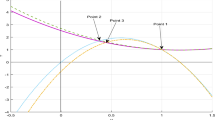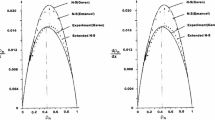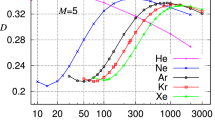Abstract
The temporal evolution of the initial shock front and the low Mach regime produced behind the front due to the sudden introduction of a spherical, finite-size, low Biot number, uniformly heated energy source in a variable property gas is investigated. While the sphere is of physical interest, analogous problems of a uniformly heated infinitely long cylindrical wire and an infinite plate are also studied. Compressibility, finite-size, and nonlinear heating effects are studied without constraining the temperature of the source. Shortly after the energy source is introduced, compressibility is significant and a strong shock wave forms which weakens as it moves away from the source eventually becoming an acoustic wave. Behind it, fluid motion occurs at a much lower speed (low Mach regime), where the resulting nonlinear heating problem is solved analytically using the method of homotopy perturbation expansion leading to weak decoupling of finite-size effects and nonlinear heating effects.







Similar content being viewed by others
References
Abramowitz, M., Stegun, I.A.: Handbook of Mathematical Functions: With Formulas, Graphs, and Mathematical Tables. Dover Publications, Mineola (1965)
Aronson, D.G.: Regularity of flows in porous media: a survey. In: Ni, W.-M., Peletier, L.A., Serrin, J. (eds.) Nonlinear Diffusion Equations and Their Equilibrium States, pp. 35–49. Springer, New York (1988)
Articolo, G.A.: PDEs and BVPs with Maple, 2nd edn. Academic Press, New York (2009)
Baddour, N.: Application of the generalized shift operator to the Hankel transform. SpringerPlus 3, 246 (2014)
Biazar, J., Ghaznavi, H.: Convergence of the HPM for partial differential equations. Nonlinear Anal. Real World Appl. 10, 2633–2640 (2009)
Crank, J.: The Mathematics of Diffusion, 2nd edn. Clarendon Press, Oxford (1975)
Cuzzi, J., Hogan, R., Paque, J., Dobrovolskis, A.: Size-selective concentration of chondrules and other small particles in protoplanetary nebula turbulence. Astrophys. J. 546, 496–508 (2001)
Davies, B.: Integral Transforms and Their Applications. Texts in Applied Mathematics, 3rd edn. Springer, New York (2002)
Devenish, B.J., Bartello, P., Brenguier, J.L., Collins, L., Grabowski, W.W., IJzermans, R.A., Malinowski, S.P., Reeks, M.W., Vassilicos, J.C., Wang, L.P., Warhaft, Z.: Droplet growth in warm turbulent clouds. Q. J. R. Met. Soc. 138, 1401–1429 (2012)
Ganguli, S.: Computational Analysis of Canonical Problems Arising in the Interaction of Heated Particles and a Fluid. Ph.D. thesis, Stanford University, Stanford, CA 94305 (2018)
Ganguli, S., Amiroudine, S.: Numerical modelling of coupled heat and momentum transfer in a porous medium saturated by a supercritical fluid. Comput. Fluids 84, 46–55 (2013)
Ganguli, S., Lele, S.: Drag of spherical particles in a periodic lattice: heat transfer, buoyancy and non-Boussinesq effects. Bull. Am. Phys. Soc. 61 (2016)
Ganguli, S., Lele, S.: Importance of variable density and non-Boussinesq effects on the drag of spherical particles. Bull. Am. Phys. Soc. 62 (2017)
Ganguli, S., Lele, S.K.: Drag of a heated sphere at low Reynolds numbers in the absence of buoyancy. J. Fluid Mech. 869, 264–291 (2019). https://doi.org/10.1017/jfm.2019.187
Graves, R.E., Argrow, B.: Bulk viscosity: past to present. J. Thermophys. Heat Transf. 13, 337–342 (1999)
He, J.H.: Homotopy perturbation technique. Comput. Methods Appl. Mech. Eng. 178, 257–262 (1999)
He, J.H.: Variational iteration method—a kind of non-linear analytical technique: some examples. Int. J. Non Linear Mech. 34, 699–708 (1999)
He, J.H.: Homotopy perturbation method: a new non-linear analytical technique. Appl. Math. Comput. 135, 73–79 (2003)
Hilsenrath, J.: Tables of Thermodynamic and Transport Properties. National Bureau of Standards Circular 564. Reprinted by Pergamon Press (1960)
Horwitz, J., Ganguli, S., Mani, A., Lele, S.: A correction procedure for thermally two-way coupled point-particles. Bull. Am. Phys. Soc. 62 (2017)
Lagerstrom, P.: Laminar Flow Theory. Princeton University Press, Princeton (1964)
Lagerstrom, P., Cole, J., Trilling, L.: Problems in the Theory of Viscous Compressible Flows. Technical report, ONR - Caltech GALCIT (1949)
McCourt, F.R., Beenakker, J.J., Köhler, W.E., Kuscer, I.: Non-Equilibrium Phenomena in Polyatomic Gases, Volume I: Dilute Gases; Volume II: Cross-Sections, Scattering and Rarefied Gases. Clarendon Press, Oxford (1990)
Necati Özişik, M.: BVPs of Heat Conduction. Dover Publications, Mineola (2002)
Noh, Y.M., Lee, H., Mueller, D., Lee, K., Shin, D., Shin, S., Choi, T.J., Choi, Y.J., Kim, K.R.: Investigation of the diurnal pattern of the vertical distribution of pollen in the lower troposphere using LIDAR. Atmos. Chem. Phys. 13, 7619–7629 (2013)
Peeters, F., Kerimoglu, O., Straile, D.: Implications of seasonal mixing for phytoplankton production and bloom development. Theor. Ecol. 6, 115–129 (2013)
Piessens, R.: The Transforms and Applications Handbook, chap. The Hankel Transform. Poularikas, A.D. (eds). CRC Press LLC, Boca Raton (2000)
Sánchez, A.L., Jiménez-Álvarez, J.L., Liñán, A.: The coupling of motion and conductive heating of a gas by localized energy sources. SIAM J. Appl. Math. 63(3), 937–96 (2003)
Sánchez-Tarifa, C., Crespo, A., Fraga, E.: A theoretical model for combustion of droplets in supercritical conditions and gas pockets. Astronaut. Acta 17, 685–692 (1972)
Sedov, L.: Propagation of Strong shock waves. Prikl. Mat. Mekh. 10, 241–250 (1946)
Taylor, G.: The formation of a blast wave by a very intense explosion. Part I. Theoretical discussion. Proc. R. Soc. Lond. A 201, 159–174 (1950)
Taylor, G.: The formation of a blast wave by a very intense explosion. Part II. The atomic explosion of 1945. Proc. R. Soc. Lond. A 201, 175–186 (1950)
Tenneti, S., Subramaniam, S.: Particle-resolved direct numerical simulation for gas-solid flow model development. Ann. Rev. Fluid Mech. 46, 199–230 (2014)
Thompson, P.A.: Compressible-Fluid Dynamics. Advanced Engineering Series. McGraw-Hill Inc, New York (1960)
Titchmarsh, E.: Eigenfunction Expansions Associated with Second Order PDEs, vol. 1, 2nd edn. Clarendon Press, Oxford (1962)
Titchmarsh, E.: Introduction to the Theory of Fourier Integrals, 2nd edn. Clarendon Press, Oxford (1967)
Van Dyke, M.: Impulsive motion of an infinite plate in a viscous compressible fluid. J. Appl. Math. Phys. 3, 343 (1952)
Wu, T.: On Problems of Heat Conduction in Compressible Fluids. Ph.D. thesis, California Institute of Technology (1952)
Zeldovich, Y.B., Raizer, Y.P.: Physics of Shock Waves and High Temperature Hydrodynamics Phenomena. English Translation. Academic Press, New York (1967)
Acknowledgements
This work was supported by the United States Department of Energy through the Predictive Science Academic Alliance Program II (PSAAP II) at Stanford University under grant number DENA0002373-1. All numerical simulations were performed on the Certainty Cluster at the Center for Turbulence Research at Stanford University.
Author information
Authors and Affiliations
Corresponding author
Additional information
Communicated by Sergio Pirozzoli.
Publisher's Note
Springer Nature remains neutral with regard to jurisdictional claims in published maps and institutional affiliations.
Appendices
Fully compressible Navier–Stokes equations in cylindrical and Cartesian coordinates
The conservation equations for mass, momentum, and energy solved in the fully compressible Navier–Stokes [21, 34] simulations when the source of energy is an infinitely long cylindrical wire placed along the z-axis (stated in cylindrical coordinates) are, respectively,
Here, \(\varPhi = \mu \left[ 2\left( \frac{\partial u_r}{\partial r}\right) ^2 - \frac{2}{3}\left( \frac{\partial u_r}{\partial r} + \frac{u_r}{r} \right) ^2\right] \) is the viscous dissipation function. Similarly, the equations when the energy source is an infinite hot plate placed along the yz-plane (stated in Cartesian coordinates) are,
The equation of state is \(p = \rho R_g T_g\).
Fluid properties used in simulations
Simulations in this paper assume that the fluid is air and has a fixed Prandtl number (Pr) of 0.7. Air is assumed to behave like an ideal gas. For air, we have for the viscosity power law \(\mu _0 = 1.716 \times 10^{-5}\) kg/m s, \(T_{\infty } = 273\) K, and \(n = \frac{2}{3}\). Other quantities are: Nominal Particle Radius, \(R = 100\)\(\upmu \)m, Ambient Fluid Temperature, \(T_{\infty } = 273\) K, Ambient Dynamic Viscosity, \(\mu _{\infty } = 1.72 \times 10^{-5}\) Pa s, Ambient Density, \(\rho _{\infty } = 1.29\)\(\frac{\mathrm{kg}}{\mathrm{m}^3}\), Heat Capacity Ratio, \(\gamma = 1.4\), Isobaric Specific Heat Capacity, \(C_p = 1.005 \times 10^3\)\(\frac{\mathrm{J}}{\mathrm{kg K}}\), Isochoric Specific Heat Capacity, \(C_v = 0.717 \times 10^3\)\(\frac{\mathrm{J}}{\mathrm{kg K}}\), Prandtl Number, \(Pr = 0.7\), and Specific Ideal Gas Constant, \(R_g = 287.058\)\(\frac{\mathrm{J}}{\mathrm{kg K}}\). Other quantities used that can be derived from these fluid properties are: Ambient Thermal Conductivity, \(\kappa _{\infty } = \mu _{\infty } C_p/Pr = 2.46 \times 10^{-2}\)\(\frac{\mathrm{W}}{\mathrm{mK}}\), Ambient Kinematic Viscosity, \(\nu _{\infty } = \mu _{\infty }/\rho _{\infty } = 1.32 \times 10^{-5}\)\(\frac{\mathrm{m}^2}{\mathrm{s}}\), Ambient Thermometric Coefficient, \(\alpha _{\infty } = \kappa _{\infty }/\left( \rho _{\infty } C_v\right) = 2.972 \times 10^{-5}\)\(\frac{\mathrm{m}^2}{\mathrm{s}}\), Ambient Thermodynamic Pressure, \(p_{\infty } = \rho _{\infty }R_g T_{\infty } = 1.01 \times 10^{5}\) Pa, and Speed of Sound in the fluid, \(a_{\infty } = \sqrt{\gamma p_{\infty }/\rho _{\infty }} = \sqrt{\gamma R_g T_{\infty }} = 331.23\) m/s. The ratio of the diffusive time scale based on the thermometric coefficient and the acoustic time scales with the relevant length scale being the particle size is called the Peclet number (\(Pe_{\infty }\)). The nominal Peclet number is \(Pe_{\infty } = 1.25 \times 10^3\).
Perturbation equations in cylindrical coordinates
On substituting (8) into (45)–(47), and (4), we obtain, respectively,
Perturbation equations in Cartesian coordinates
On substituting (8) into (48)–(50), and (4), we obtain, respectively,
Low Mach equations in cylindrical and Cartesian coordinates
The governing equations (45)–(47) of the fluid in the low Mach regime for an infinitely long cylindrical wire become
The governing equations (48)–(50) of the fluid in the low Mach regime for an infinite plate become
The equation of state is \(p_0 = \rho R_g T_g\), where \(R_g\) is the specific gas constant of air (287.058J / kg / K).
Rights and permissions
About this article
Cite this article
Ganguli, S., Lele, S.K. Low Mach, compressibility, and finite size effects of localized uniform heat sources in a gas. Theor. Comput. Fluid Dyn. 33, 341–358 (2019). https://doi.org/10.1007/s00162-019-00496-w
Received:
Accepted:
Published:
Issue Date:
DOI: https://doi.org/10.1007/s00162-019-00496-w




